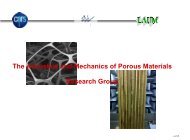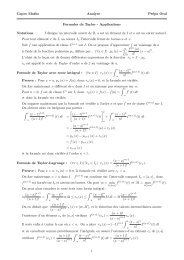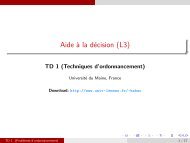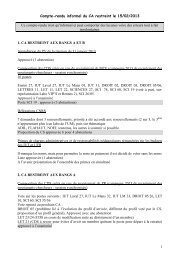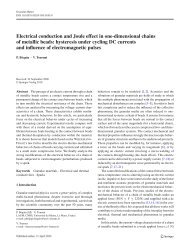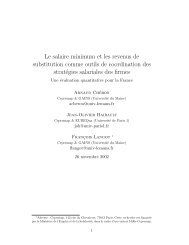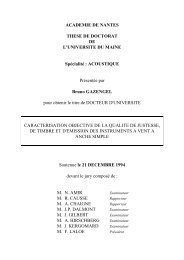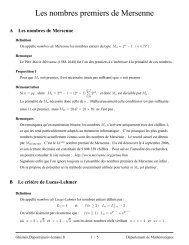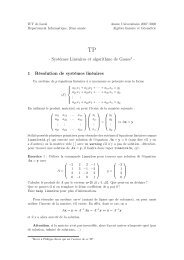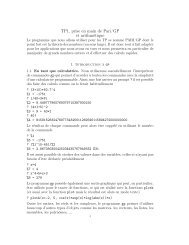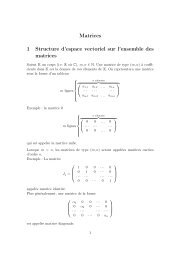Noise generated by cavitating single-hole and multi-hole orifices in ...
Noise generated by cavitating single-hole and multi-hole orifices in ...
Noise generated by cavitating single-hole and multi-hole orifices in ...
Create successful ePaper yourself
Turn your PDF publications into a flip-book with our unique Google optimized e-Paper software.
ARTICLE IN PRESSP. Testud et al. / Journal of Fluids <strong>and</strong> Structures 23 (2007) 163–189 165Fig. 1. Flow through an orifice <strong>and</strong> correspond<strong>in</strong>g evolution of the static pressure.We prefer to use the cavitation number, based on the pressure drop across the s<strong>in</strong>gularity generat<strong>in</strong>g the jet:P vs ¼ P 2DP , (3)where DP ¼ P 1 P 2 is the pressure drop across the orifice, with P 1 the static pressure upstream of the orifice <strong>and</strong> P 2 thedownstream static pressure far away from the orifice. In this choice, we follow common practice <strong>in</strong> <strong>in</strong>dustry (Tullis,1989; Franc et al., 1999; Lecoffre, 1994).One should note that both those cavitation numbers lead to very similar classifications as they are related to eachother <strong>by</strong> the pressure drop coefficient of the s<strong>in</strong>gularity.When the pressure P j has a sufficiently low value, <strong>in</strong>termittent t<strong>in</strong>y cavitation bubbles are produced <strong>in</strong> the heart of theturbulent eddies along the shear layer of the jet. This flow regime transition is called cavitation <strong>in</strong>ception, <strong>and</strong> it appearsat a cavitation number of the order of 1 (when d=D ¼ 0:30) accord<strong>in</strong>g to the data of Tullis (1989). Other references(Numachi et al., 1960; Tullis <strong>and</strong> Gov<strong>in</strong>dajaran, 1973; Ball et al., 1975; Yan <strong>and</strong> Thorpe, 1990; Kugou et al., 1996; Sato<strong>and</strong> Saito, 2001; Pan et al., 2001) are <strong>in</strong> good agreement with the values <strong>and</strong> scale effects given <strong>by</strong> Tullis (1989). Somedifferences result from the <strong>in</strong>fluence of the variation <strong>in</strong> the dissolved gas content <strong>and</strong> <strong>in</strong> the viscosity (Keller, 1994).As the jet pressure decreases further, more bubbles with larger radii are <strong>generated</strong>, form<strong>in</strong>g a white cloud. Thepressure fluctuations <strong>in</strong>crease <strong>and</strong> a characteristic shot noise can be heard. A further decrease <strong>in</strong> jet pressure <strong>in</strong>duces theformation of a large vapor pocket just downstream of the orifice, surround<strong>in</strong>g the liquid jet. The regime occurr<strong>in</strong>g afterthis transition is called super cavitation <strong>and</strong> it exhibits the largest noise <strong>and</strong> vibration levels. In the super cavitationregime, noise is known [see, for example, Van Wijngaarden (1972)], to be ma<strong>in</strong>ly <strong>generated</strong> <strong>in</strong> a shock transitionbetween the cavitation region <strong>and</strong> the pipe flow, at some distance downstream of the orifice. Downstream of the shock,some residual gas (air) bubbles can persist but pure vapor bubbles have disappeared.Cavitation <strong>in</strong>dicators are used to predict the occurrence of cavitation regimes. The use of two of them has seemedrelevant, <strong>in</strong> view of our experimental results. First, a so-called <strong>in</strong>cipient cavitation <strong>in</strong>dicator, noted s i , which predicts thetransition from a non<strong>cavitat<strong>in</strong>g</strong> flow to a moderately <strong>cavitat<strong>in</strong>g</strong> flow, that is called developed cavitation regime. Second,a so-called choked cavitation <strong>in</strong>dicator, noted s ch , which predicts the transition from a moderately <strong>cavitat<strong>in</strong>g</strong> flow to asuper <strong>cavitat<strong>in</strong>g</strong> flow, with the formation <strong>and</strong> cont<strong>in</strong>uous presence of a vapor pocket downstream of the orifice aroundthe liquid jet. To calculate both those <strong>in</strong>cipient <strong>and</strong> the choked cavitation <strong>in</strong>dicators, scal<strong>in</strong>g laws are given <strong>by</strong> Tullis(1989). They take <strong>in</strong>to account the various pressure effects <strong>and</strong> size scale effects, <strong>by</strong> means of extensive experiments on<strong>s<strong>in</strong>gle</strong>-<strong>hole</strong> <strong>orifices</strong> <strong>in</strong> water pipe flow. For <strong>multi</strong>-<strong>hole</strong> <strong>orifices</strong>, as mentioned <strong>in</strong> the same work, less data are available butidentical values are expected to hold.Only a few studies provide downstream noise spectra <strong>generated</strong> <strong>by</strong> <strong>cavitat<strong>in</strong>g</strong> <strong>orifices</strong> (Yan et al., 1988; Bistafa et al.,1989; Kim et al., 1997; Pan et al., 2001). A few complementary studies give the noise spectra created <strong>by</strong> <strong>cavitat<strong>in</strong>g</strong> valves



